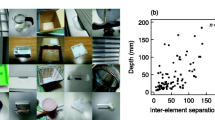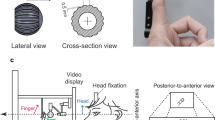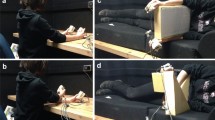Abstract
As the hand actively explores the environment, contact with an object leads to neuronal activity in the topographic maps of somatosensory cortex. However, the brain must combine this somatotopically encoded tactile information with an internal representation of the hand's location in space if it is to determine the position of the object in three-dimensional space (3-D haptic localization). To investigate the fidelity of this internal representation in human subjects, a small tactual stimulator, light enough to be worn on the subject's hand, was used to present a brief mechanical pulse (6-ms duration) to the right index finger before, during, or after a fast, visually evoked movement of the right hand. In experiment 1, subjects responded by pointing to the perceived location of the mechanical stimulus in 3-D space. Stimuli presented shortly before or during the visually evoked movement were systematically mislocalized, with the reported location of the stimulus approximately equal to the location occupied by the hand 90 ms after stimulus onset. This pattern of errors indicates a representation of the movement that fails to account for the change in the hand's location during somatosensory delays and, in some subjects, inaccurately depicts the velocity of the actual movement. In experiment 2, subjects were instructed to verbally indicate the perceived temporal relationship of the stimulus and the visually evoked movement (i.e., by reporting whether the stimulus was presented “before,” “during,” or “after” the movement). On average, stimuli presented in the 38-ms period before movement onset were more likely to be perceived as having occurred during rather than before the movement. Similarly, stimuli in the 145-ms period before movement termination were more likely to be perceived as having occurred after rather than during the movement. The analogous findings of experiments 1 and 2 indicate that the same inaccurate representation of dynamic hand position is used to both localize tactual stimuli in 3-D space and construct the perception of arm movement.
Similar content being viewed by others
References
Andersson O, Grillner S (1983) Peripheral control of the cat's step cycle. II. Entrainment of the central pattern generators for locomotion by sinusoidal hip movements during “fictive locomotion”. Acta Physiol Scand 118:229–239
Atkeson CG, Hollerbach JM (1985) Kinematic features of unrestrained vertical arm movements. J Neurophysiol 5:2318–2330
Bischof N, Kramer E (1968) Untersuchungen und überlegungen zur Richtungswahrnehmung bei willkürlichen sakkadischen Augenbewegungen. Psychol Forsch 32:185–218
Boring EG (1942) Sensation and perception in the history of experimental psychology. Appleton-Century, New York
Chapman CE, Bushnell MC, Miron D, Duncan GH, Lund JP (1987) Sensory perception during movement in man. Exp Brain Res 68:516–524
Cole LE (1929) The localization of tactual space. Genet Psychol Monogr 5:339–447
Coquery J-M (1978) Role of active movement in control of afferent input from skin in cat and man. In: Gordon G (ed) Active touch. Pergamon, Oxford, pp 161–169
Cordo PJ (1990) Kinesthetic control of a multijoint movement sequence. J Neurophysiol 63:161–172
Cordo P, Carlton L, Bevan L, Carlton M, Kerr GK (1994) Proprioceptive coordination of movement sequences: role of velocity and position information. J Neurophysiol 71:1848–1861
Dassonville P, Georgopoulos AP (1994) Characteristics of the representation of hand in space for 3-D tactile localization. Soc Neurosci Abstr 20:992
Dassonville P, Nagode JC (1995) Tactile localization during discrete and continuous movements of different speeds. Soc Neurosci Abstr 21:1921
Dassonville P, Schlag J, Schlag-Rey M (1992) Oculomotor localization relies on a damped representation of saccadic eye displacement in human and nonhuman primates. Vis Neurosci 9:261–269
Dassonville P, Boline J, Georgopoulos AP (1993a) A dynamic representation of hand in space for 3-D tactile localization. Soc Neurosci Abstr 19:147
Dassonville P, Schlag J, Schlag-Rey M (1993b) Direction constancy in the oculomotor system. Curr Dir Psychol Sci 2:143–147
Desmedt JE, Cheron G (1981) Non-cephalic reference recording of early somatosensory potentials to finger stimulation in adult or aging normal man: differentiation of widespread N18 and contralateral N20 from the prerolandic P22 and N30 components. Electroencephalogr Clin Neurophysiol 52:553–570
Dyhre-Poulsen P (1975) Increased vibration threshold before movements in human subjects. Exp Neurol 47:516–522
Dyhre-Poulsen P (1978) Perception of tactile stimuli before ballistic and during tracking movements. In: Gordon G (ed) Active touch. Pergamon, Oxford, pp 171–176
Feine JS, Chapman CE, Lund JP, Duncan GH, Bushnell MC (1990) The perception of painful and nonpainful stimuli during voluntary motor activity in man. Somatosens Mot Res 7:113–124
Fukson OI, Berkinblitt MB, Feldman AG (1980) The spinal frog takes into account the scheme of its body during the wiping reflex. Science 209:1261–1263
Gandevia SC, Burke D (1992) Does the nervous system depend on kinesthetic information to control natural limb movements? Behav Brain Sci 15:614–632
Giszter SF, McIntyre J, Bizzi E (1989) Kinematic strategies and sensorimotor transformations in the wiping movements of frogs. J Neurophysiol 62:750–767
Gnadt JW, Bracewell RM, Andersen RA (1991) Sensorimotor transformation during eye movements to remembered visual targets. Vision Res 31:693–715
Honda H (1990) Eye movements to a visual stimulus flashed before, during, or after a saccade. In: Jeannerod M (ed) Motor representation and control. (Attention and performance, XIII) Lawrence Erlbaum, Hillsdale, pp 567–582
Horch KW, Clark FJ, Burgess PR (1975) Awareness of knee joint angle under static conditions. J Neurophsyiol 38:1436–1447
Jirsa R, Radil T, Maras L (1992) Perception of timing of movementonset in a simple reaction time task. Neuroreport 3:524–526
Lackner JR, Taublieb AB (1984) Influence of vision on vibrationinduced illusions of limb movement. Exp Neurol 85:97–106
Loomis JM, Lederman SJ (1986) Tactual perception. In: Boff KR, Kaufman L, Thomas JP (ed) Handbook of perception and human performance, vol II. Wiley, New York, pp 1–41
Matin L, Matin E (1969) Visual perception of direction when voluntary saccades occur. I. Relation of visual direction of a fixation target extinguished before a saccade to a flash presented during the saccade. Percept Psychophys 5:65–80
Matin L, Pearce DG (1965) Visual perception of direction for stimuli flashed during voluntary saccadic eye movement. Science 148:1485–1488
Matin L, Matin E, Pola J (1970) Visual perception of direction when voluntary saccades occur. II. Relation of visual direction of a fixation target extinguished before a saccade to a subsequent test flash presented before the saccade. Percept Psychophys 8:9–14
Matin L, Picoult E, Stevens J, Edwards M, MacArthur R (1982) Oculoparalytic illusion: visual-field dependent spatial mislocalizations by humans partially paralyzed with curare. Science 216:198–201
McCloskey DI (1981) Corollary discharges:motor commands and perception. In: Brooks VB (ed) Motor control (Handbook of physiology, sect 1, The nervous system, vol II, part 2) American Physiological Society, Bethesda, pp 1415–1447
McCloskey DI, Colebatch JG, Potter EK, Burke D (1983) Judgements about onset of rapid voluntary movements in man. J europhysiol 49:851–863
Milne RJ, Aniss AM, Kay NE, Gandevia SC (1988) Reduction in perceived intensity of cutaneous stimuli during movement: a quantitative study. Exp Brain Res 70:569–576
Nagode JC, Dassonville P (1995) Effects of movement velocity on the perceived location of the hand in space during a tactile localization task. J Invest Med 43 (Supplement 2):292A
Oldfield RC (1971) The assessment and analysis of handedness: the Edinburgh inventory. Neuropsychologia 9:97–113
Paillard J, Brouchon M (1968) Active and passive movements in the calibration of position sense. In: Freedman SJ (ed) Neurophysiology of spatially oriented behavior. Dorsey, Homewood, Ill, pp 37–55
Pick HL Jr, Warren DH, Hay JC (1969) Sensory conflicts in judgements of spatial direction. Percept Psychophys 6:203–205
Post LJ, Zompa IC, Chapman CE (1994) Perception of vibrotactile stimuli during motor activity in human subjects. Exp Brain Res 100:107–120
Prablanc C, Echallier JE, Jeannerod M, Komilis E (1979) Optimal response of eye and hand motor systems in pointing to a visual target. II. Static and dynamic visual cues in the control of hand movement. Biol Cybern 35:183–187
Rock I, Harris CS (1967) Vision and touch. Sci Am 216:96–104
Schmidt RF, Schady WJL, Torebjörk HE (1990a) Gating of tactile input from the hand. I. Effects of finger movement. Exp Brain Res 79:97–102
Schmidt RF, Torebjörk HE, Schady WJL (1990b) Gating of tactile input from the hand. II. Effects of remote movements and anaesthesia. Exp Brain Res 79:103–108
Shimojo S (1987) Attention-dependent visual capture in double vision. Perception 16:445–447
Sittig AC, Denier van der Gon JJ, Gielen CCAM (1987) The contribution of afferent information on position and velocity to the control of slow and fast human forearm movements. Exp Brain Res 67:33–40
Volkmann FC, Moore RK (1978) Saccadic eye movements and the perception of a clear and continuous visual world. In: Armington JC, Krauskopf J, Wooten BR (eds) Visual psychophysics and physiology. Academic, New York, pp 353–362
Weinstein S (1968) Intensive and extensive aspects of tactile sensitivity as a function of body part, sex, and laterality. In: Kenshalo DR (ed) The skin senses. Thomas, Springfield, Ill, pp 195–222
Author information
Authors and Affiliations
Rights and permissions
About this article
Cite this article
Dassonville, P. Haptic localization and the internal representation of the hand in space. Exp Brain Res 106, 434–448 (1995). https://doi.org/10.1007/BF00231066
Received:
Accepted:
Issue Date:
DOI: https://doi.org/10.1007/BF00231066




